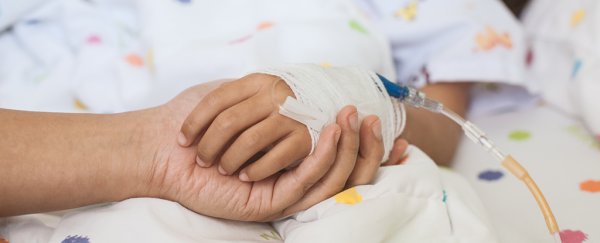A new study estimating childhood cancer has revealed a worrying trend - nearly half the kids in the world who get cancer, including many from Asia and Africa, might never get properly diagnosed – and that means they never get any treatment.
Faced with these shocking numbers, the researchers behind the study are calling for improved access to healthcare in developing nations, along with more complete record-taking.
The statistic is based on a computer model that processed data on cancer incidence, healthcare availability, and referral rates. The model was then checked for accuracy against cancer registries in 77 countries, and arrived at an estimate of incidence and diagnosis of childhood cancer worldwide.
The conclusions were rather dire.
"Childhood cancer is substantially underdiagnosed, especially in south Asia and sub-Saharan Africa (including western, eastern, and southern Africa)," write the researchers.
"In addition to improving treatment for childhood cancer, health systems must be strengthened to accurately diagnose and effectively care for all children with cancer."
Based on the estimates, 397,000 kids worldwide aged up to 14 would have got cancer in 2015, but diagnosis figures for the year sit at 224,000. That means 43 percent of cases could be going undetected.
While just 3 percent of childhood cancer cases in western Europe and the US were missed in 2015, the model calculates, that figure jumps up to 49 percent in south Asia and 57 percent in western Africa.
Either these kids aren't getting looked at by health professionals or their symptoms are being confused with other conditions such as tuberculosis or malaria, the team behind the study suggests.
"Cancer survival even among diagnosed cases is already poor in these countries, but it is going to be basically zero percent for children if they are not identified," one of the team, Zachary Ward from Harvard University in Massachusetts, told Nicola Davis at the The Guardian.
The study has more grim statistics to share. The data shows that the number of childhood cancer cases that occur in low-income and middle-income countries (where access to treatment is less likely) is higher than we thought – perhaps over 90 percent rather than the previous estimate of around 80 percent.
And based on the figures the computer model predicts, 6.7 million kids across the world will get cancer between 2015 and 2030, with 2.9 million of those going undiagnosed.
The study does have some limitations which are worth pointing out: several regions had small samples of cancer registry data (only two countries in western Africa for example), and referrals for other health issues were sometimes used as proxies for cancer referrals.
The biggest challenge was the lack of real-world data from cancer registries in some regions, something the researchers directly address in their paper.
"Registry data from additional countries would help to better account for potential heterogeneity and control for outliers in cancer incidence within regions," the team writes.
"However, as new country-specific data become available, our model can be refined to provide updated estimates."
Even with the limitations, the results of this estimate are a stark warning about the urgency of improving health provisions at all levels of the system across the world to catch more of these cases, and to get that rather alarming 43 percent figure lower – especially as cancer treatments continue to improve.
The research has been published in Lancet Oncology.
